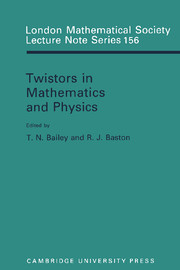Book contents
- Frontmatter
- Preface
- Contents
- 1 Twistor Theory After 25 Years—its Physical Status and Prospects
- 2 Between Integral Geometry and Twistors
- 3 Generalized Conformal Structures
- 4 Riemannian Twistor Spaces and Holonomy Groups
- 5 Twistors, Ambitwistors, and Conformal Gravity
- 6 The Penrose Transform
- 7 Notation for the Penrose Transform
- 8 The Twistor Transform
- 9 Invariant Operators
- 10 Penrose's Quasi-local Mass
- 11 The Sparling 3-form, Ashtekar Variables and Quasi-local Mass
- 12 Twistors and Strings
- 13 Integrable Systems in Twistor Theory
- 14 Twistor Characterization of Stationary Axisymmetric Solutions of Einstein's Equations
- 15 A Two-surface Encoding of Radiative Space-times
- 16 Twistors, Massless Fields and the Penrose Transform
- 17 Twistor Diagrams and Feynman Diagrams
- 18 Cohomology and Twistor Diagrams
- Authors' addresses
11 - The Sparling 3-form, Ashtekar Variables and Quasi-local Mass
Published online by Cambridge University Press: 05 May 2013
- Frontmatter
- Preface
- Contents
- 1 Twistor Theory After 25 Years—its Physical Status and Prospects
- 2 Between Integral Geometry and Twistors
- 3 Generalized Conformal Structures
- 4 Riemannian Twistor Spaces and Holonomy Groups
- 5 Twistors, Ambitwistors, and Conformal Gravity
- 6 The Penrose Transform
- 7 Notation for the Penrose Transform
- 8 The Twistor Transform
- 9 Invariant Operators
- 10 Penrose's Quasi-local Mass
- 11 The Sparling 3-form, Ashtekar Variables and Quasi-local Mass
- 12 Twistors and Strings
- 13 Integrable Systems in Twistor Theory
- 14 Twistor Characterization of Stationary Axisymmetric Solutions of Einstein's Equations
- 15 A Two-surface Encoding of Radiative Space-times
- 16 Twistors, Massless Fields and the Penrose Transform
- 17 Twistor Diagrams and Feynman Diagrams
- 18 Cohomology and Twistor Diagrams
- Authors' addresses
Summary
In this article we review some basic results connnected with the use of the ‘Sparling 3-form’, a 3-form defined on the spin bundle of space-time. It is closed if and only if the vacuum equations are satisfied. This structure unifies, at least partially, some of the major spinorial developments in GR.
Ashtekar's spinorial variables for general relativity are extended to covariant variables for space-time and the Einstein-Hilbert action is given in terms of these. The reduction to the canonical formalism yields the Sparling 3-form as the gravitational Hamiltonian derived from the Einstein-Hilbert action. It is the gravitational part of Witten's integrand for the ADM energy. We derive Penrose's quasi-local mass formula from the associated boundary term when the form is restricted to appropriate sections of the spin bundle. The components of the angular momentum twistor for a 2-surface S arise as Hamiltonians generating motions of a spanning 3-surface that tend to motions generated by quasi-Killing vectors obtained from solutions of the 2-surface twistor equation on S. Connections with super-gravity are discussed.
We present some related ideas. The 3-form extends to one of a collection of 3-forms on the bundle of general frames. When pulled back to spacetime using a coordinate section of the frame bundle, this collection gives the pseudo-energy-momentum tensor of the gravitational field.
Information
- Type
- Chapter
- Information
- Twistors in Mathematics and Physics , pp. 189 - 217Publisher: Cambridge University PressPrint publication year: 1990
Accessibility standard: Unknown
Why this information is here
This section outlines the accessibility features of this content - including support for screen readers, full keyboard navigation and high-contrast display options. This may not be relevant for you.Accessibility Information
- 9
- Cited by
